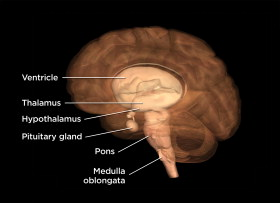The Forebrain
Another area, the forebrain, contains the thalamus, hypothalamus and pituitary gland. It is almost completely surrounded by the cerebral hemispheres and contains a cavity known as the third ventricle. The thalamus is a tightly packed cluster of nerve cells that relays impulses from the sense organs to the cortex. The hypothalamus controls hunger, thirst, temperature, aggression and sex drive; it also controls the pituitary gland, which controls the secretion of many hormones.
 The reticular formation is an intricate network of nuclei and nerve fibers within the medulla oblongata, pons, midbrain, thalamus and hypothalamus that functions as the reticular activating system. This contains the sensory pathways from the spinal cord to the brain and is important in maintaining a state of alert consciousness.
The reticular formation is an intricate network of nuclei and nerve fibers within the medulla oblongata, pons, midbrain, thalamus and hypothalamus that functions as the reticular activating system. This contains the sensory pathways from the spinal cord to the brain and is important in maintaining a state of alert consciousness.
Looped around the brain stem and hypothalamus are the structures of the limbic system, which are thought to be involved in emotional responses such as fear, aggression and mood changes. The brain also has four fluid-filled cavities called ventricles where cerebrospinal fluid is produced.
The singular most amazing thing about the human brain may be its plasticity. We are learning more all the time about the ability of the brain to adjust and relearn, even after something as devastating as brain injury caused by a stroke. And that is nothing short of awe-inspiring.




